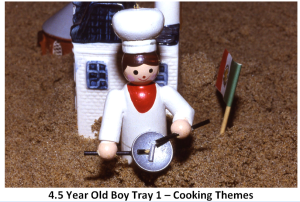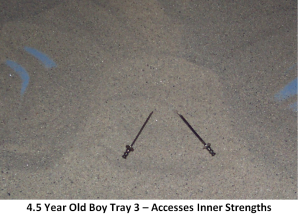Why Sandplay therapy?
This is a guest article written by Dr. Celia van Wyk.
An Introduction.
While studying for my BA in Counselling, my lecturer one day approached me, asking if I would be interested in attending an information session on sandplay therapy. As an ex-teacher who felt that I had “moved on” since my teaching years, more working with adults at that point, I was not particularly interested. She asked me again a while later, and I decided to attend for the sake of just knowing what it is about. Little did I know that sandplay therapy is suitable for adults as well.
This decision changed my whole course of life and career. I was fascinated by what the therapy entails, and as someone who vaguely learned about Carl Jung somewhere along my study years as young student, I remembered how his concepts intrigued me. Within the course of one morning an excitement took hold of me as well as a deep desire to learn more and to find out more about Jungian Sandplay Therapy.
My research started, but with little or no avail. I could not find a tertiary institution or society in South Africa teaching or offering any further studies in this modality, which lead me to more and deeper research on the World Wide Web, the result of this was me getting in touch with the Jung Institute in Zürich, Switzerland, where I immediately applied to attend their Winter Intensive Program. This journey led me to intensive theoretical training not only in Switzerland, but also in USA, and South Africa, when Dr. Martin Kalff was invited as teacher here in 2009.
The theory side was accompanied by my own personal sandplay process, and practical individual and group supervision. In October of this year 2013 I am so fortunate to be able to attend further group supervision in Bucharest, Romania.
The modality of Jungian sandplay therapy touched me on a very special and deep core level, and the success in my health centre with my clients’ emotional health is heart-warming, and fills me with much respect and honour for the beauty and capabilities of the human psyche.
About Sandplay Therapy
Sandplay therapy is a form of psychotherapy with roots extending back to the foundations of child psychotherapy in the early 20th century. Sandplay is now widely used with adults as well as children.
The sandplay method consists of the psychotherapy client’s creation of a three-dimensional picture with miniature figures in a tray of sand in the protective presence of a trained practitioner. The sand tray is 72.4 cm long by 49.5 cm wide and 7.6 cm deep (Kalff, D.M., 2004.) The sides and bottom of the inside of the sand tray are coloured light blue. By moving the sand aside, the blue coloration can be used to represent areas of water in the sandy landscape. Real water can be added to the sand to make it adaptable to being shaped and sculpted. Miniature figures representing all aspects of life and fantasy are arranged on shelves near the sand tray. A wide variety of building materials out of which the client can fashion needed items is also available.
The therapist encourages the client to make whatever he or she likes in the sand tray and is given no further instructions. The miniature figures, or collection, include representations of all parts of life and fantasy. In addition, there are building materials available to make unique items when needed. As the client works in the sand tray the therapist sits nearby making note of what figures the client uses and what the client says, or does, if anything. The therapist sketches or “maps” a diagram of the sand tray for future reference. The therapist takes photographs when the sand tray is completed, and will study them to deepen his or her understanding of the client’s symbolic work in the tray.
How Sandplay Therapy Works
The client’s work in the sand tray is image based and pre-verbal. It accesses the right hemisphere, allowing the client to bypass left hemispheric rationality and to deal directly with the image, symbol and feeling-rich content. Clients will frequently comment that they have no idea why they did what emerged in the sand tray. Some will say, “My hands just led me.” We now know from current research in neuroscience that all learning and development occurs first in the right hemisphere and is subsequently integrated into the conscious knowing of the left hemisphere. Researchers at the Boston Change Study Group determined that the words exchanged in psychotherapy have very little effect on the client’s healing and development. Rather it is the understanding exchange between the mirror neuron circuits of client and therapist that effect therapeutic change (2010 Siegel, D.) In sandplay the right hemisphere guides the selection and placement of the images and symbols that the client chooses from the collection. They thus become three dimensional and concrete in the sand tray. In addition they are witnessed by the sandplay therapist. The sandplay client and therapist jointly see and experience the symbolic creation in the sand tray. This facilitates a powerful circuit of reinforcement feedback between the mirror neuron networks of client and therapist. Thus the therapist’s non-verbal recognition of the client’s pre-conscious work affirms its reality and thus fixes it in place to become conscious to the client.
A little boy deals with loss
When the client works in the sand tray the psyche begins its work at its point of arrest. For example this may be a trauma that occurred in the past. I recall one little 4.5 year old boy I worked with who had suffered many losses including divorce in the family, the destruction of the house by fire, death of his favourite grandmother and his mother’s mortal illness.
His sandplay work began with themes of cooking and food preparation. His psyche gathered fuel for his journey ahead. He then began to access inner strength and power. I recall one tray where he buried a pair of silver swords. Following this he was able to symbolically confront the loss of his home and the death of his grandmother. I recall a phase of his grief expressed through a prominent garbage can with a witch flying above it. He had cleverly hung the witch from a tall hook. In the left portion of the tray was a large tornado form and on top of the hook was a silver trophy. Symbolically he acknowledges the destructive forces beyond his control, the tornado, the evil and unfair nature of it, the witch, and develops the capacity to contain the losses, the garbage can. Underscoring his healing and growth the young client placed the young boy atop the ox from the Zen Ox Herding Pictures to the left of the trash can. This is picture six from the Ox Herding series, symbolizing the return home after a successful journey. His new growth is also reflected in his prominently placed trophy which stands above the entire scene.
Practicing Sandplay Therapy
On the surface sandplay appears deceptively simple. However it is one, if not the, most powerful form of psychotherapy when practiced by a well trained and experienced clinician.
In order for sandplay to be effective and safe, the therapist must be able to understand and safely contain the client’s symbolic work in the tray (Weinrib, E.L., 2004.) This requires extensive study of theory and practice of sandplay, undergoing the sandplay process as a client, and a rich understanding of the cross cultural symbolism from anthropology, fairy tale, mythology, religious traditions and rituals. The scope of the material the sandplay therapist must be able to draw from and synthesize a fundamental understanding of the client’s work in the tray is vast. Training standards and certification requirements in sandplay are managed by the International Society for Sandplay Therapists.
Treatment Applications for Sandplay
Sandplay therapy has shown to be beneficial across a broad spectrum of clinical presentations. It is generally recommended that the child client be a minimum of 3.5 – 4 years old to begin meaningful work in the sand. Unless the clinician is very experienced with psychotic disorders it is not recommended that clinicians use sandplay with this population. The imagery could easily overwhelm these patients. There are however, highly experienced clinicians in this area who do use sandplay to help schizophrenic patients become more grounded in their material reality (Turner, B.A. 2005.) Sandplay is an excellent medium for treatment of trauma and early childhood wounding. Sandplay can be very effective in cases of endogenous depression or anxiety disorders in conjunction with proper medical management.
I always tell my clients that Sandplay works like a strengthening therapy, where regression happens to a point of trauma or pain arrest where from the healing journey needs to start, and then progress. This process will lead them to knowledge of the Inner Self, their identity, personality, who and what they are, and how to function as their own unique individual in their world, comfortable and in balance.
South African Sandplay Trainings by Dr. Barbara Turner PhD (USA) For information on dates please follow this link http://www.sandplay.co.za/course-dates.html
Information Seminars are presented in Johannesburg by Dr. Celia van Wyk. For more information on these workshops and seminars, please contact Dr. Celia at info@sandplay.co.za or phone her on 011 794-2750.
References
International Society for Sandplay Therapists www.isst-society.com
Sandplay South Africa www.sandplay.co.za
Sandplay Training www.barbaraturner.org
Kalff, D.M., 2004. Sandplay: A psychotherapeutic approach to the psyche. Temenos Press: Cloverdale, CA.
Seigel, D.J., 2010. Mindsight: The new science of personal transformation. Bantam: New York.
Turner, B.A., 2005. The handbook of sandplay therapy. Temenos Press: Cloverdale, CA.
Weinrib, E.L., 2004. Images of the self: The sandplay therapy process. Temenos Press: Cloverdale, CA.
About Sastas
Sastas is a South African Sandplay Therapy Interest Group, promoting “Health & Healing Transformation through the use of Sandplay Therapy”. SASTAS is a non-profit South African Group focusing to create interest in Jungian Sandplay to be used as therapy towards balance and healing of trauma and mental issues on different levels of the psyche.
 Celia van Wyk, PhD (Hon) is the administrator of Sastas and the organiser of the international training presented in South Africa by Barbara Turner, PhD.
Celia van Wyk, PhD (Hon) is the administrator of Sastas and the organiser of the international training presented in South Africa by Barbara Turner, PhD.
Dr. Celia van Wyk Dr. Alt. Med. B.A Couns. PhD (Hon) has over years undergone studies and intensive training in Sandplay Therapy in various countries, presented by ISST (International
Society for Sandplay Therapists) teachers. She completed her Advanced Post Graduate Training in Sandplay Therapy in the USA with Dr. Barbara Turner in March 2011. Celia has completed her personal sandplay process and supervision under the leadership of her ISST mentors. She is passionate about Jungian Sandplay Therapy!
Dr. Celia established good business relationships in sandplay which was preceded with personal meetings with most prominent international ISST leaders, members and associations of the world and their chairpersons.
Dr. Celia is a registered Natural Health and Mental Health Practitioner and Herbalist and holds a bachelors degree in Counselling – Mental Health. She received an honoris causa doctorate from New World Mission Dunamis International University where she also serves as Lecturer Mental Health. She is also a registered practitioner with the Traditional Healer’s Organization of South Africa.






Leave a Reply